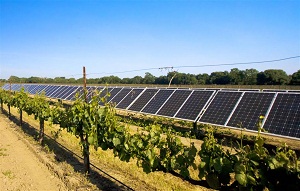Green vines make green wine
 Cade Winery, in northern California’s famous Napa Valley, was recognized earlier this week with a gold-level Leadership in Energy and Environmental Design. It’s the first vineyard in the valley to receive this level of recognition for its entire operation.
Cade Winery, in northern California’s famous Napa Valley, was recognized earlier this week with a gold-level Leadership in Energy and Environmental Design. It’s the first vineyard in the valley to receive this level of recognition for its entire operation.
Among numerous other green measures, the vineyard owners installed more than an acre of photovoltaic panels. The panels provide about 99 percent of the energy the vineyard needs, according to the vintner’s web site.
Cade is not alone. Starting in 2005, vineyards started to use unplanted acreage for cultivating a different sort of money crop.
Frog’s Leap, a vineyard that produces internationally known and award-winning wine, was the first to switch to solar.
The vineyard’s general manager, Jonah Beer, told a Bnet.com reporter in 2007 that the decision to go green didn’t have so much to do with saving the environment as it did to do with the bottom line in the business.
The vineyard installed over 1,000 PV panels at a cost of $600,000 in 2005, Beer said. Now, the panels save the vineyard $50,000 a month in energy bills.
“We produce enough electricity to power over 150 homes,” Beer said. “Over the 30-year life of the system, we’ll reduce our CO2 emissions by 1,600 tons.” He said that’s equal to you not driving 4 million miles in your car.
While solar has proved profitable in Napa, some winery owners say they went green out of principle.
Larry Maguire, partner and president at Far Niente, a luxury wine producer, told CNN last year that he switched to solar because he thought it was the right thing to do, though he expected when he did it that it would not be a wise economic decision.
In 2005, He switched Far Niente along with sister vineyards Nickel and Nickel and Dolce entirely to solar.
The wineries each installed more than 2,000 PV panels, which together produce about 770 kW during peak sunlight hours.
Maguire said the decision made business sense even when he thought it might hurt the bottom line in the short term.
"Napa Valley is located in one of the world's few chosen spots for growing magnificent Cabernet Sauvignon," Maguire said. "Our future and the future of Napa Valley hinges on weather. Global warming is not a good thing for us."



